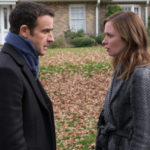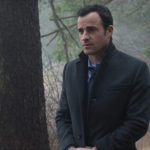Girl on the Train, based on the novel of the same name by Paula Hawkins, is adapted and scripted by a woman (Erin Cressida Wilson), directed by a man (Tate Taylor), features a largely female cast (three women share the lead) and carries with it a feminist message about how women are treated by men, but the brutal denouement and moral only slip into focus during the final third of the film.
The first two thirds are dominated by apparently random, hazy, fragmented, kaleidoscopic images, many intense close-up shots and woozy ambiguity designed to bamboozle audiences into the same state of confusion as the central character Rachel Watson (Emily Blunt, whose faux-naïf performance in Sicario drew many compliments), much as Danny Boyle did to James McAvoy‘s Simon in Trance, in preparation for the inevitable twists.
At first it appears she is looking out of the train at a random perfect couple, but the more we delve beneath the surface the more personal connections become apparent. Watson is an alcoholic who blames the alcoholic blackouts for the loss of her memory and marriage to Tom (Justin Theroux.)
She can’t stop looking at the house where he now lives with new wife Anna (Rebecca Ferguson), baby daughter Evie, plus their nanny and near-neighbour Megan Hipwell (Haley Bennett) as she passes on the train into New York. Later it emerges that she was sacked from her job over a year ago but still travels into Grand Central from the plush waterside area she once called home, and later still that Tom also lost his job – for which her alcoholic behaviour has been blamed. Rachel blames herself for everything, wherein lies the message.
Most of the movie centres on the back story of the three women and Rachel’s attempts to rediscover her memory, especially in light of the real theme: the police investigation into the disappearance of Megan, magnificently led by Alison Janney‘s calm but perceptive Detective Sgt Riley. Janney, by the way, is an actress I greatly admire, not least for her world weary attitude of having come through everything life had to offer and survived.
Rachel finds reself a suspect but not the only one – Megan’s husband Scott (Luke Evans) also falls under the radar. The investigation escalates when Megan’s body is discovered, she having been brutally battered to death, apparently while Rachel was following her, though gaps in her memory and flashes of what may be real or faux-memory worthy of Don’t Look Now justifiably scare the hell out of Rachel.
From this point on, I need not describe any of the action, since you know already what will happen. Rather than the inevitability of a Greek tragedy, the effect is rather more a slight but unavoidable let-down. The flashback structure is not wholly convincing and the overall impact, which begins with a poetic flourish, becomes lifeless predictability.
Maybe this is the inevitability, since films focusing on characters with amnesia are almost ten a penny. Trance tried to do too much, but at least it went off-piste and break from the shock horror discovery in the final reel that the anti-hero is in fact blameless and victim of a plot or circumstances.
This is a shame, because the cast are to a (wo)man strong and convincing. Emily Blunt looks the very picture of a woman struggling with a clouded memory and a manipulated past – and worse, the very real possibility that she might have perpetrated a murder without knowing it. For her, I predict a great future with leading roles playing pithy characters in three dimensions, fully deserved and the benefit of having done an apprenticeship on stage with great performers like Judi Dench.
Friends who have read the book say the film is vastly inferior, but then that is true of almost every adaptation since you can never cram in all the microscopic levels of detail and nuances of thought (though I still think Zinnemann‘s Day of the Jackal is superior to the book, even if I am the only one to think so!) That said, every film should stand up in its own right, divorced from the source material. This example got very mixed reviews, of which I will quote one example, courtesy of Rotten Tomatoes‘s critics consensus:
“Emily Blunt’s outstanding performance isn’t enough to keep The Girl on the Train from sliding sluggishly into exploitative melodrama.”
On this they have a point, because the last half hour of the movie could be any TV melodrama. All the ambiguity and images should build into a coruscating finale, but I came out feeling this was too easy a cop-out, more an anticlimax than a spine-tingling shocker. If you spotted the feminist seam running through the script, you will not have been remotely surprised by the ending, vicious though it was.
There is also an opportunity missed, since the previous and current wives of Tom Watson are united by one thing (see the movie to find out what that is), yet they don’t speak and barely look at one another. What’s the psychology here? At any rate, in the final shot, Rachel sits on the other side of the train in a different carriage and looks at the water instead. Maybe she even got another job in New York, who knows?
Here’s Millward’s moral of the tale: just be careful with the corkscrew, OK?













